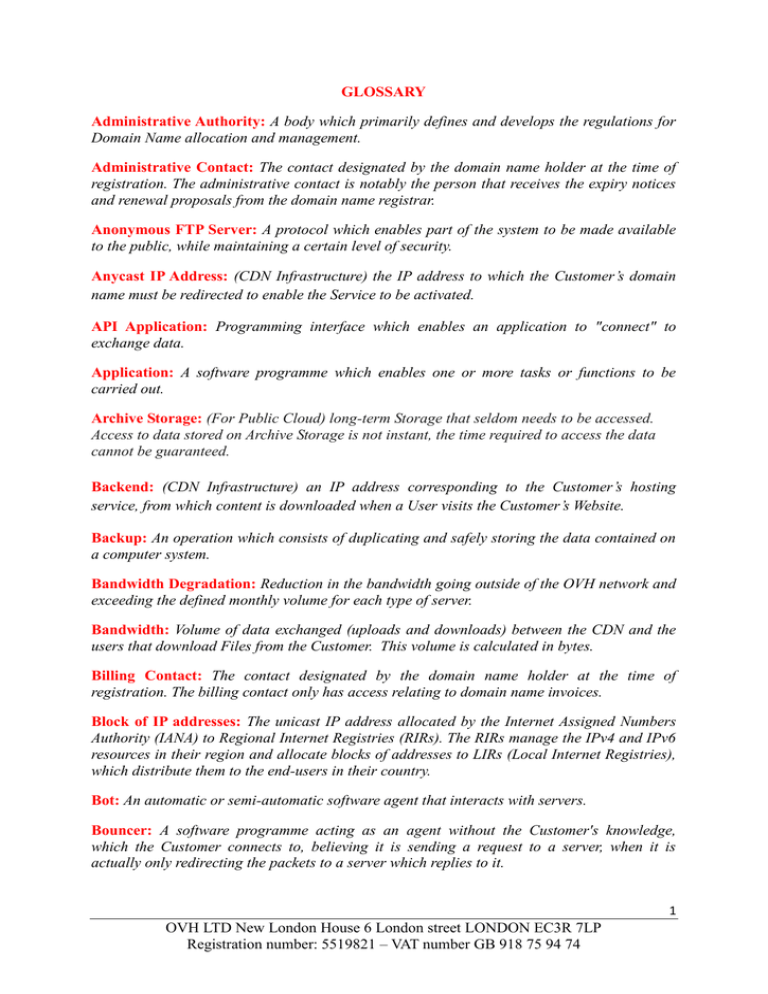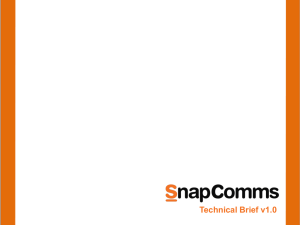UK glossary
advertisement

GLOSSARY Administrative Authority: A body which primarily defines and develops the regulations for Domain Name allocation and management. Administrative Contact: The contact designated by the domain name holder at the time of registration. The administrative contact is notably the person that receives the expiry notices and renewal proposals from the domain name registrar. Anonymous FTP Server: A protocol which enables part of the system to be made available to the public, while maintaining a certain level of security. Anycast IP Address: (CDN Infrastructure) the IP address to which the Customer’s domain name must be redirected to enable the Service to be activated. API Application: Programming interface which enables an application to "connect" to exchange data. Application: A software programme which enables one or more tasks or functions to be carried out. Archive Storage: (For Public Cloud) long-term Storage that seldom needs to be accessed. Access to data stored on Archive Storage is not instant, the time required to access the data cannot be guaranteed. Backend: (CDN Infrastructure) an IP address corresponding to the Customer’s hosting service, from which content is downloaded when a User visits the Customer’s Website. Backup: An operation which consists of duplicating and safely storing the data contained on a computer system. Bandwidth Degradation: Reduction in the bandwidth going outside of the OVH network and exceeding the defined monthly volume for each type of server. Bandwidth: Volume of data exchanged (uploads and downloads) between the CDN and the users that download Files from the Customer. This volume is calculated in bytes. Billing Contact: The contact designated by the domain name holder at the time of registration. The billing contact only has access relating to domain name invoices. Block of IP addresses: The unicast IP address allocated by the Internet Assigned Numbers Authority (IANA) to Regional Internet Registries (RIRs). The RIRs manage the IPv4 and IPv6 resources in their region and allocate blocks of addresses to LIRs (Local Internet Registries), which distribute them to the end-users in their country. Bot: An automatic or semi-automatic software agent that interacts with servers. Bouncer: A software programme acting as an agent without the Customer's knowledge, which the Customer connects to, believing it is sending a request to a server, when it is actually only redirecting the packets to a server which replies to it. 1 OVH LTD New London House 6 London street LONDON EC3R 7LP Registration number: 5519821 – VAT number GB 918 75 94 74 Business continuity planning (BCP): This plan identifies an organisation's exposure to internal and external threats and synthesizes hard and soft assets to provide effective prevention and recovery for the organisation, while maintaining competitive advantage and value system integrity. Cache: (CDN Infrastructure, CDN WebStorage), Local memory of the CDN Server (CDN POPs). CDN: The Content Delivery Network is network of servers which cooperate to make content and data available to users via the internet. CGI Script: A programme executed by the web server which allows a HTML code, which is created automatically by the server, to be sent to the internet user's browser. Cloud: Technology that uses remote execution resources and storage. Connector Technology: All techniques related to the physical connections of the electric cabling, as well as data transmissions (connectors, plugs and sockets). Content: The text, information, image, audio or video material and other data placed on the Service by or on behalf of the Customer, including data which the Customer permits third parties to place on the Service. CPU: The Central Processing Unit, or processor, is the server component which executes the computer programmes. CSS (Cascading Style Sheets): A style sheet language used to manage the presentation and formatting of a web page. Customer’s Website: A set of pages and content globally accessible via a domain name, which constitute the Customer’s Website (with more than one Website constituting “Websites”). Data Transfer Rate: Quantity of data transmitted via a communication channel in a given time interval. The speed of an internet connection is generally expressed in kbps (kilobits per second). (D)DOS: (distributed) denial-of-service attack; an attempt to make a machine or network resource unavailable to its intended users. Dedicated Cloud: All of the Virtual Datacentres hosted on the OVH Infrastructure. The Dedicated Cloud is managed by the Customer through its management interface and the Virtualisation interface. Dedicated Server: A server made available to a single customer by the hosting provider. Only the customer manages the machine. The customer alone chooses which elements to host on its machine. OVH is only responsible for performing maintenance work, and for the energy suppy and network connection. Diagnostic: A set of measures and tests performed out in order to determine or verify the technical aspects of a problem, and to evaluate the cause and effects of it. 2 OVH LTD New London House 6 London street LONDON EC3R 7LP Registration number: 5519821 – VAT number GB 918 75 94 74 Direct file address: Specific URL address to which the Customer’s hypertext link should be redirected to enable Service activation. DNS Server: The protocol which enables a domain name to be associated with an address IP. Domain Name Holder: The natural or legal person who, under a registration contract with a domain registrar, pays a remuneration fixed by registrar in exchange for the allocation of a domain name. Domain Name: An identification string (e.g. ovh) and an extension (e.g. .com, .fr etc.), constituting a familiar name which is associated with an IP address. Dynamic Content: Changeable content that varies based on various parameters such as User web browser, session, etc. Firewall: The firewall can be software or hardware-based and it enables adherence to the network security policy, which defines the authorised types of communication on this computer network. It analyses applications and packets. FreeBSD: A free UNIX-like operating system. Front End Server: Microsoft) Computer device. FTP File: The FTP protocol enables the transfer of Files from local machine to a remote machine. FTP Server: It enables the files to be transferred via the internet or via a local computer network (intranet). gTLD: Generic top-level domain or extension (.com, .biz, .net…). Hard Disk: The Hard Disk (or HD) is a magnetic device for digital data storage. Host Server: A physical server with a memory load and a processor load. It is configured and managed by OVH within its Dedicated Cloud, and is designed to accommodate one or several Virtual Machines managed by the Customer. HTML: HyperText Markup Language is a data format designed to display web pages. HTTP Server: The software used to send requests in compliance with the client-server communication protocol; the Hypertext Transfer Protocol (HTTP). Hyperlink: A hypertext reference in the document currently being viewed which automatically leads to a related document. ICMP Flow: The Internet Control Message Protocol is one of the fundamental protocols of the Internet Protocol Suite. It is used to transmit control and error messages for this protocol suite, for example when a service or a host is inaccessible. Incident Service: Service offered by OVH enabling the Customer to declare a technical incident. OVH will perform a diagnostic. If the diagnostic reveals that the incident falls within 3 OVH LTD New London House 6 London street LONDON EC3R 7LP Registration number: 5519821 – VAT number GB 918 75 94 74 the Supplier's remit, then resolution of the incident falls under the service guarantee framework. Failing this, the diagnostic will be invoiced to the Customer. Infrastructure: (Dedicated Cloud) The structure established by OVH to accommodate the Customer's Dedicated Cloud, which notably includes the network, the bandwidth, the physical resources and the Virtualisation. (Virtual Private Server, Public Cloud and DeskaaS) All components provided by OVH include in particular (depending on the circumstance) the Host Server, the Storage Space, the network, the bandwidth and/or virtualisation or cloud computing technology. (Public Cloud) All the elements developed by OVH. This especially includes, the Host Server, Storage, network, bandwidth and virtualisation and / or cloud technology, as appropriate. Instance: (Public Cloud) Virtual server created on the OVH Public Cloud infrastructure and which enables the development and/or use of application solutions. The Instance, created using cloud computing technologies, includes a Storage Space and a quantity of processor and RAM resources. It is possible to add Object Storage to an Instance. Intrusion: The unauthorised access of a computer system in order to read its internal data or to use its resources. iOS Application: A type of mobile application developed specially for the Apple iPhone, the iPod Touch and the iPad. IP Address: The number which identifies each device connected to the internet. The interface with the network for all computer hardware. IPv4: Internet Protocol version 4 or IPv4 is the first IP version to be widely deployed, and forms the basis of the internet. IPv6: The new generation Internet Protocol, which notably has a much greater address capacity than the IPv4 protocol currently in use. IRC: Internet Chat Relay is an internet text messaging communications protocol. For example, it is used for instant communication, mainly in the form of group chat via discussions forums known as channels or chat rooms. ISP/Access Provider: Internet service provider/internet access provider. Linux Kernel: A kernel of a UNIX-like operating system. +Local Storage: (Public Cloud) Storage that is local to the Instance’s Host Server. There are different types of Local Storage: non-redundant Local Storage (no data replication) and Local Storage based on Raid technology. The data is deleted and the disk is reinstalled in its original state each time the Instance is deleted or reinstalled. Log: A log (or logfile) which chronologically presents all events that have affected a computer system and all actions resulting from these events, in the classic text file format. MAC Address: The physical identifier stored on a network card or a similar network interface, and used to globally assign a unique address at link layer level. 4 OVH LTD New London House 6 London street LONDON EC3R 7LP Registration number: 5519821 – VAT number GB 918 75 94 74 Mailing List: The mailing or distribution list is a specific email usage which enables the mass sending of information to the users subscribed to the list. Management Interface: The "Manager" space is accessible to the Customer after identification by inputting its customer ID and the corresponding password. MySQL: A free database management system. Netboot: (Total Security SD) is a rescue solution which enables a dedicated server to be rebooted on a software kernel designed by OVH. Network File System: The network filing system and network protocol for sharing this filing system. It enables files to be shared transparently, mainly between UNIX systems. Network Loop: The entire OVH network. Any traffic passing outside of the Network Loop is regarded as external to the OVH network. Newsgroup: A discussion space for a given topic, which operates asynchronously on the internet, meaning that the users can leave messages for other users to read when they log in. Object Storage Container: Distributed Storage Space based on the Object Storage architecture (management of data as objects). Operating System (OS): The programme that controls how the server capacity is used by managing all application programmes. Outgoing Transfer: The transfer of the domain name to another registrar. Order: a request made by the Customer to the Supplier for Services to be supplied under the Terms and Conditions. OVH Account: An invoicing account containing all the functionalities and information related to the OVH billing services. The OVH account can be credited by the Customer and can act as a cash reserve that can be used as a means of payment for invoices issued for new OVH services or renewal of subscribed OVH services. The Customer can also nominate a payment method (such as bank card, bank account) that will enable its invoices to be paid automatically. Pack: Dedicated Cloud offer with Host Servers and Storage Spaces configured in a Virtual Datacentre, and possible additional options. Parameter Rules: (CDN Infrastructure) Parameters set out by the Customer to determine the rules to be applied to the temporary storage of static Website content (Cache). (Geocache Accelerator): Parameters set out by the Customer specifying the rules applied to the temporary storage of static content of the Website (Cache). 5 OVH LTD New London House 6 London street LONDON EC3R 7LP Registration number: 5519821 – VAT number GB 918 75 94 74 Peer to Peer File Exchange: is a network which enables file sharing across several computers connected by the internet, enabling each internet user to be a server and receiver of another internet user. PHP: A programming language mainly used to produce dynamic web pages via a HTTP server. Piracy: A computer crime which consists of adapting a software design in order to violate the integrity of a system for malicious purposes, or to copy information without permission to distribute or sell it. Points of Presence: Physical locations on the OVH network of CDN Servers connected to the Internet, as presented in its commercial offering (CDN infrastructure, Geocache Accelerator, CDN WebStorage). Port Scanning: A technique for finding the open ports of a network server. Pro-forma Invoice: an invoice drawn up as the final invoice, but which is not a legal request for payment on behalf of the issuing party. It is only used to support credit applications or administrative requests. Processor: See CPU. Proxy: A software component which acts as an intermediary by placing itself between two others to facilitate or supervise their exchanges. Rack: A cabinet used to store the servers and other computer or telecoms equipment. RAID Technology: Techniques enabling the same data to be stored on several hard disks in order to improve the fault tolerance, security, and performance of the unit. RAM (Random-Access Memory) The computer storage memory system used by the server when processing data. Registrar: A service provider which provides domain name registration and management. The registrars are accredited by the registry. Registry: An entity (in the form of a company or an association) responsible for the organisation, administration and management of an extension (.com, .fr. .eu, etc). Registry duties include database and public research centre maintenance, registrar accreditation, registration of domain names requested by the accredited registrars, and operating the servers. Remote Storage: (Public Cloud) Storage attached to an Instance via a network. Remote Storage can be distributed or not, and have different levels of redundancy (replication). Remote Storage (including data stored on it) is deleted when the Instance to which it is attached is deleted or reinstalled. Reverse: This is the determination of a domain name that is associated with a given IP address. 6 OVH LTD New London House 6 London street LONDON EC3R 7LP Registration number: 5519821 – VAT number GB 918 75 94 74 Root Privileges: The conventional name given to the user with all permissions on the system, in both mono mode and multi-user mode. Root: Special user rights for the UNIX operating system. Router: Intermediary element on a computer network which forwards data packets. Rsync: A free file synchronisation software programme distributed under GNU GPL licence. Security Loophole: A weakness in a computer system, which enables an attacker to harm the integrity of this system, meaning its normal operation, and the confidentiality and integrity of the data it contains. Service: all services provided by the Supplier to the Customer in accordance with the Terms and Conditions. Service Activation: The Service will be activated once the Customer's payment has been validated, at which point the Supplier will establish the Customer's Service and will send access codes to the Customer to enable its administration. Shared Hosting: Internet hosting in a technical environment, with the main characteristic being that it is shared by several users. SIP Software: The peer to peer voice over Internet Protocol which is often used in multimedia telecommunications (internet telephony, video telephony, instant messaging etc). Snapshot: Logical volumes which enable a coherent backup to be made of another logical volume, from the same group of volumes. Creating a snapshot consists of taking a “photo” of the state of the target logical volume, which is used to save modifications made to target logical volume. Sniffing: Monitoring data packets flowing over a line, in order to randomly (and unlawfully) obtain interesting packets (containing the word “password” for example). Software Application: A type of software designed to automate user activities. Source Code: A set of instructions written in a high level computer programming language, which is comprehensible to a trained human being, and can be used to produce a computer programme. Spamming: The sending of unsolicited bulk emails. Spoofing: or electronic identity theft. A technique which consists of concealing the true address that an email has been sent from, and replacing it with a fake one. SQL Injection: Type of security loophole exploit in an application interacting with a database, by injecting an SQL request/DDoS attack/Cross-site scripting, which is not expected by the system and compromises its security. SQL Server: A database management system developed and marketed by the company Microsoft. 7 OVH LTD New London House 6 London street LONDON EC3R 7LP Registration number: 5519821 – VAT number GB 918 75 94 74 SSD: The Solid-State Drive is a flash memory hard disk enabling a faster startup speed than the standard hard disk. SSH: A secure communications protocol. SSL Protocol: A data transfer security standard used for data encryption, and authentication of the server and all messages, notably used by online payment and transaction systems. Static Content: Content that doesn’t change, consisting of things like CSS or images, not intended to be viewed differently on the website by two different users. Storage Space: The disk space allocated to the Customer enabling it to store the data of the Virtual Machine in the Virtual Datacentre in a centralised and secure manner. For Public Cloud: Disk space, onto which, an Instance’s data can be stored. Storage can be either a Local or Remote, depending on the characteristics of the Instance. Among the Storage available within the OVH Public Cloud service, OVH offers Archive Storage and Object Storage Containers. Streaming: A mode of audio and video data transmission. The data is transmitted continuously as soon as the internet user requests the file, rather than after downloading the entire video and audio clip. Supplier: OVH Limited, a private company incorporated and registered in England and Wales under No05519821, whose registered office is at Lincoln House, 300 High Holborn London WC1V 7JH, VAT No GB 918759474. Switching: Operation on a Virtual Private Server to move from one configuration to a higher configuration of the same range. Switching to a lower range configuration (with a lower monthly price than the existing configuration) is not authorised. This operation is done via hot swapping, the Virtual Private Server may restart immediately. Technical Contact: The contact designated by the domain name holder at the time of registration. The technical contact is notably the person that manages the technical aspects of the domain name. Terminal: The peripheral device(s) enabling communication with a server. Time-Series Data or data points: Data for measuring a component of the Customer's system and characterised by a common identifier and a set of time-stamped values. All of these values represent the change over time in the value or measure associated with the identifier. Thus, a CPU temperature measure will correspond to a point, a weather station that measures the temperature, humidity and pressure corresponds to three points. (CDN WebStorage) Space to which the Customer transfers their files in order to enable OVH to then store them in the CDN servers. (Time-Series Platform) Disk space used to save Time-Series Data for a Project. This space is shared between different Projects and different OVH customers, the data is isolated logically per Project. 8 OVH LTD New London House 6 London street LONDON EC3R 7LP Registration number: 5519821 – VAT number GB 918 75 94 74 (Virtual Desktop) Dedicated disk space, situated on a shared server, and rented to the Customer logically so that they can store Virtual Desktop data provided by OVH. (Public Cloud) All the elements provided by OVH especially (depending on the case), the Host Server, the Storage Space, the network, the bandwidth and the virtualisation and/or Cloud technology. Time-Series Platform: Environment enabling the implementation of a solution for collecting, aggregating, storing and processing large volumes of Time-Series Data especially from systems or objects connected to the internet or another network. The Time-Series Platform contains an infrastructure (Storage Space, network, bandwidth, machine capacity etc.) a database engine, Storage Space and API. TOR Server: A decentralised global network of routers, organised in layers known as onion routers, which anonymously relay TCP flow. Traffic: Refers to the flow of information circulating on the global computer networks. Traffic Credit: (CDN Infrastructure, CDN WebStorage) Volume of data that may be credited by the Customer to their account and from which User connections are debited. Only traffic between the CDN Server and the User is debited, and not the traffic between the CDN Server and the Customer’s Website hosting service. TXT Field: A text box or an input field. UDP: The User Datagram Protocol, a protocol which can be used in place of TCP when transmission reliability is not critical. It provides a smoother transfer as it does not monitor every stage of the transmission. Unlisting: Removal of an address IP. Unlocking: A technique that consists of bypassing the protections on a system to remove the usage restrictions set up by the manufacturer. URL: The uniform resource locator is an internet resource address (e.g. file). The format of a URL is a universal standard with the following structure: http://www.example.com/search/index.html Users: (CDN infrastructure, CDN WebStorage) Internet users visiting the Customer Website. (Geocache Accelerator): Internet users downloading the Customer’s Files. Virtual Datacentre: A non-physical datacentre composed of a Pack, additional resources subscribed to by the Customer, Virtual Machines, and one or several private network(s). Virtual Machine: A non-physical server that uses Virtual Datacentre resources and is installed on the Dedicated Cloud network. Each virtual machine is managed independently from any other within the Customer's Virtual Datacentre. 9 OVH LTD New London House 6 London street LONDON EC3R 7LP Registration number: 5519821 – VAT number GB 918 75 94 74 Virtualisation Interface: Third party software provided by OVH that allows the Customer to manage its Dedicated Cloud and the associated services, and in particular to establish and manage its Virtual Machines. Virtualisation: Technology that allows multiple systems, virtual servers or applications to operate on a same physical server. VPN: A virtual private network (VPN) extends a private network across a public network, such as the Internet. It enables a computer to send and receive data across shared or public networks as if it were directly connected to the private network, while benefiting from the functionality, security and management policies of the private network. VPS Models/Offers: The amount of resources (CPU, RAM, storage) of the VPS. This is the minimum number of resources allocated for a given billing period. Virtual Desktop or “DeskaaS”: Virtualised workstation consisting of hardware resources containing one or more CPU, RAM capacity and Storage Space, located on a Host Server, as well as pre-installed applications, accessible from different platforms (including PC, tablet, smartphone) via Cloud technologies. Web Requests: Requests made the web browser to the HTTP server when attempting to download a web page. Webmin: A web server management interface which is accessed using a browser. Whois: A public database search facility which can be used to identify the domain name holder or IP address owner. XSS: Cross-site scripting (XSS) is a type of computer security vulnerability typically found in plications 10 OVH LTD New London House 6 London street LONDON EC3R 7LP Registration number: 5519821 – VAT number GB 918 75 94 74




